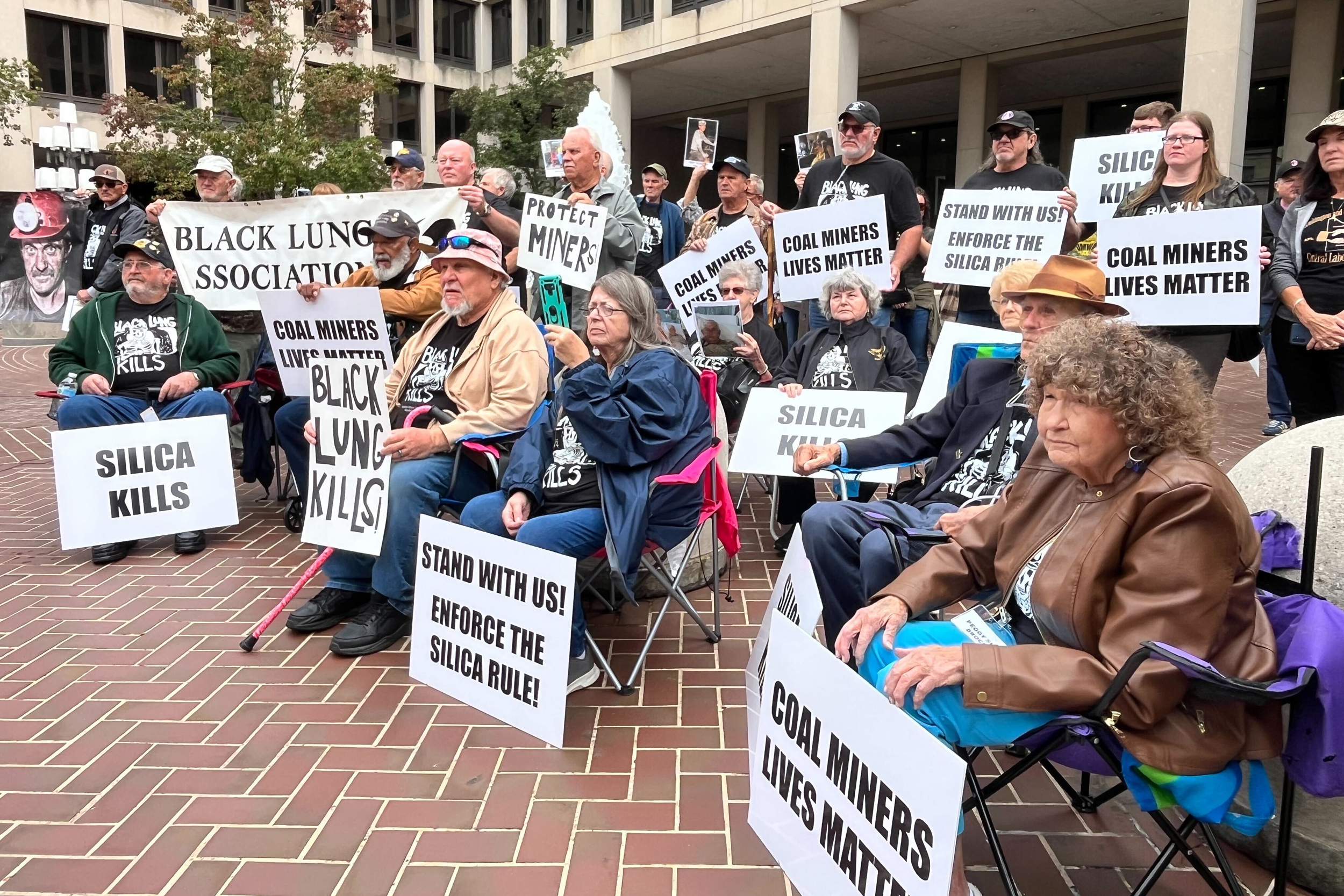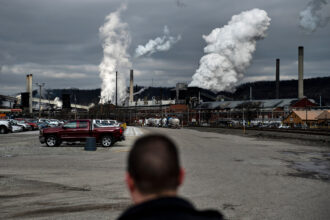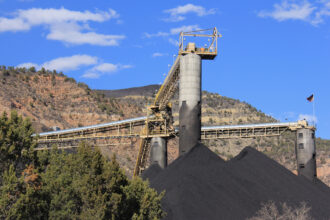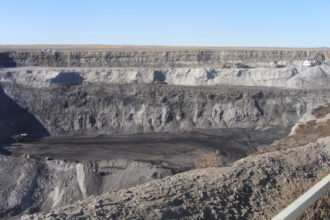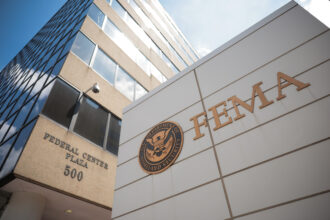Coal miners, their family members and union representatives rallied outside of the U.S. Department of Labor’s headquarters in Washington on Tuesday morning, urging the Trump administration to enforce a rule that was meant to protect miners from serious health complications but has been on hold for months.
The rally, which included members of the National Black Lung Association and the United Mine Workers of America (UMWA), sought to highlight how lax industry standards for exposure to dangerous substances have impacted workers, and demand the government move forward with stricter protections.
A new Biden-era rule, which went into effect in June 2024, was meant to limit miners’ exposure to silica dust, which is released during the mining process. Those tiny silica particles can cause dangerous and irreversible damage to miners’ health, including black lung, silicosis, lung cancer and other diseases.
“If we don’t [enforce the rule], this is just going to be an earlier death sentence for our miners,” said Vonda Robinson, vice president of the National Black Lung Association. “28 years old, 30, 35 years old and passing away—that shouldn’t be.”
The rule requires mining companies to lower exposure limits for silica to half the previously permitted amount. It also requires mine operators to monitor workers’ exposures to silica dust, compel them to provide periodic health examinations at no cost to miners and update standards for respiratory protection.
For Robinson and many of the attendees, the fight is personal. Robinson’s husband was diagnosed with black lung at 47 years old and is now “totally disabled,” Robinson said. Some attendees at the rally carried portable oxygen machines, while others held up pictures of loved ones who had died from the disease.
Black lung has been on the rise in the past 20 years, despite previously having been on the decline since the 1970s. In central Appalachia, the disease now affects one in five miners with 25 years of mining experience, according to the UMWA.
Coal mines were originally required to comply with the new rule by April 14, 2025. However, the Mine Safety and Health Administration (MSHA) pushed back that deadline by four months just days before it was set to be implemented, citing the administration’s restructuring of the National Institute for Occupational Safety and Health as the reason for the pause.
“Given the unforeseen NIOSH restructuring, and other technical reasons, MSHA offers this four-month temporary pause to provide time for operators to secure necessary equipment and otherwise come into compliance,” MSHA said at the time.
Legal challenges filed by industry groups, including the National Stone, Sand & Gravel Association (NSSGA) and the National Mining Association (NMA), prompted the Eighth U.S. Circuit Court of Appeals to issue a temporary stay halting enforcement of the rule.
In a statement, NMA spokesperson Ashley Burke said that the association is “absolutely supportive of the new lower levels,” but that the rule “needs to allow for the use of administrative controls and personal protective equipment for compliance with the standard to supplement and enhance engineering controls.”
“The MSHA rule must align with the Occupational Safety and Health Administration’s silica rule on methods of compliance,” Burke said, adding that OSHA “has adopted a strict but workable approach to achieve these same silica levels; we are asking for consistency across government.”
Critics have said that those measures—such as rotating shifts and the use of respirators—are insufficient, arguing the practices would only increase the number of workers exposed to the dust and don’t sufficiently protect miners. The rule instead requires mining companies to implement engineering controls, such as ventilation and water sprays, as the primary method to meet lower exposure limits.
MSHA chose not to defend the rule in court, instead asking the Eighth Circuit in August to keep the case on hold as it discusses a potential settlement with the industry groups.
The agency also successfully urged the court to reject attempts by the American Thoracic Society, UMWA and United Steelworkers to intervene in the case in defense of the rule.
The administration has now requested a third delay from the court due to the federal government shutdown.
To some of those present at Tuesday’s rally, those moves represented a backslide on Trump’s promises to support coal workers.
Trump is a vocal ally of the coal industry and has taken steps to boost production of the fuel in his first months in office. The president’s signature One Big Beautiful Bill Act mandated that millions of acres of federal lands be made available for mining, and his administration has consistently sought to prop up the industry in executive and regulatory actions.
“President Trump said we’re going to dig, baby dig,” said Robinson. “OK, we can do that, but let’s take care of the health and safety of our miners.”
“I would ask him—put a pillow over your face, and that’s how these coal miners breathe. They smother every day,” Robinson said.
In an emailed statement, White House spokesperson Anna Kelly said that “President Trump cares deeply about unleashing America’s energy potential, as well as standing up for those who fuel our country, such as hardworking coal miners.”
“Blue collar Americans played a key role in sending President Trump back to the White House because they know he has their back, and with the help of great leaders across the administration … he is working tirelessly to deliver policies that improve the livelihoods of working families across the nation,” Kelly said.
But Jason Walsh, a former Obama administration official and executive director of the BlueGreen Alliance, a coalition of labor unions and environmental organizations, said that Trump’s pro-coal rhetoric represented empty promises to the workers underpinning the industry.
“President Trump loves to use coal miners as political props. But when the cameras are turned off, he couldn’t care less whether they’re sick or healthy,” Walsh said.
“This is a guy who digs coal, loves coal, calls it beautiful. But what he really digs is coal industry profits. He really digs PAC checks from coal company CEOs. He couldn’t care less about miners or the communities they live in.”
About This Story
Perhaps you noticed: This story, like all the news we publish, is free to read. That’s because Inside Climate News is a 501c3 nonprofit organization. We do not charge a subscription fee, lock our news behind a paywall, or clutter our website with ads. We make our news on climate and the environment freely available to you and anyone who wants it.
That’s not all. We also share our news for free with scores of other media organizations around the country. Many of them can’t afford to do environmental journalism of their own. We’ve built bureaus from coast to coast to report local stories, collaborate with local newsrooms and co-publish articles so that this vital work is shared as widely as possible.
Two of us launched ICN in 2007. Six years later we earned a Pulitzer Prize for National Reporting, and now we run the oldest and largest dedicated climate newsroom in the nation. We tell the story in all its complexity. We hold polluters accountable. We expose environmental injustice. We debunk misinformation. We scrutinize solutions and inspire action.
Donations from readers like you fund every aspect of what we do. If you don’t already, will you support our ongoing work, our reporting on the biggest crisis facing our planet, and help us reach even more readers in more places?
Please take a moment to make a tax-deductible donation. Every one of them makes a difference.
Thank you,


